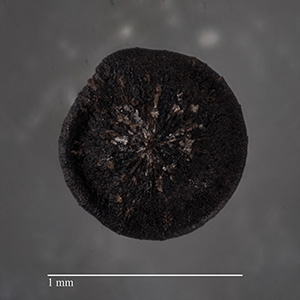Chenopodium palmeri Standley
North Amer. Flora 21: pp19. 1916
Etymology |
In honor of Edward Palmer (1829–1911) explorer, archeologist, and prolific plant collector. |
Description: |
Ill-scented erect annual, 6-8 dm. high, much branched above, the branches strongly ascending, slender, obtusely angled, pale-greenish, copiously but very finely farinose; petioles slender, equaling or two thirds as long as the blades; leaf-blades broadly rhombic-ovate, 1.5-2.5 cm. long, rounded or broadly obtuse at the apex, apiculate, rounded or broadly cuneate at the base, entire, or usually with 2 small rounded lobes at the base, very thin, green and glabrate on the upper surface, densely but very finely and closely farinose beneath, the upper blades smaller, entire, obtuse; flowers in small glomerules, these in slender, dense or interrupted, paniculate spikes, the inflorescence ample, open, with slender, nearly naked branches ; calyx densely farinose, deeply cleft, the lobes oval or broadly oblong, incompletely enclosing the fruit; pericarp adherent; seed horizontal, 0.7-0.8 mm. broad, dark reddish-brown, shining, nearly smooth, the margin obtuse. - Standley |
Distribution: |
USA: AZ Mexico: BS, CH, DG, SO |
Synonyms: |
Chenopodium neomexicanum Standl. var. palmeri (Standl.) T.W. Walters |
Type: |
Palmer 9: US 48302 |
Website Info: |
We thank all the Herbaria who have very generously have allowed us to display their images. All images with a RED outline were either provided by the linked Herbaria or given us access to their website to obtain such images, or they were scanned while on loan to us. Please see the credits and further information by clicking on the Herbaria acronyms. The specimens’ images without such red outline, were taken by us during our research visits. All fruit and seed images have been taken with the Visionary Digital Microscope System, Dun, Inc. Palmyra, VA by Lee Simpson at San Diego State University. Website development by Lee Simpson. Contact: sdsuherbarium@sdsu.edu |
Map:
(click here if map does not load)
Habitat and Field Images
Palmer 9
Specimens:
Sanders 9439
Van Devender 92-951
Gentry 20481
Felger 1416
Van Devender 1063
|
Wiggins 316
Rebman 9664 (pericarp lost)
 |
 |
 |
 |
Dominguez 349
 |
 |
Knobloch 507
 |
 |
Rea 1268
 |
 |
Van Devender 659
Jones 28610
Van Devender 92-1381
Leon de la Luz 8700
 UCR 140927 Provance 9542 |
















































